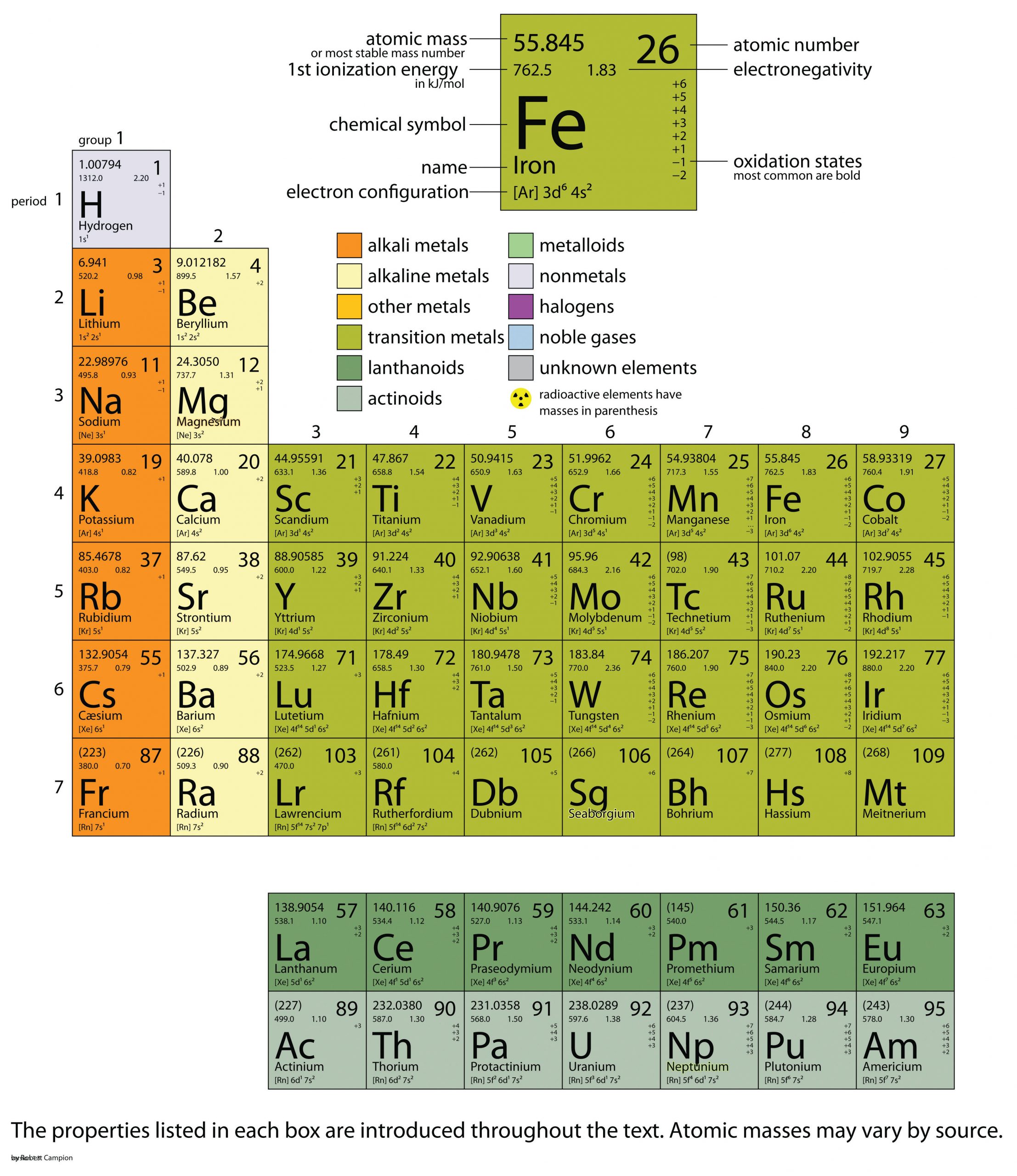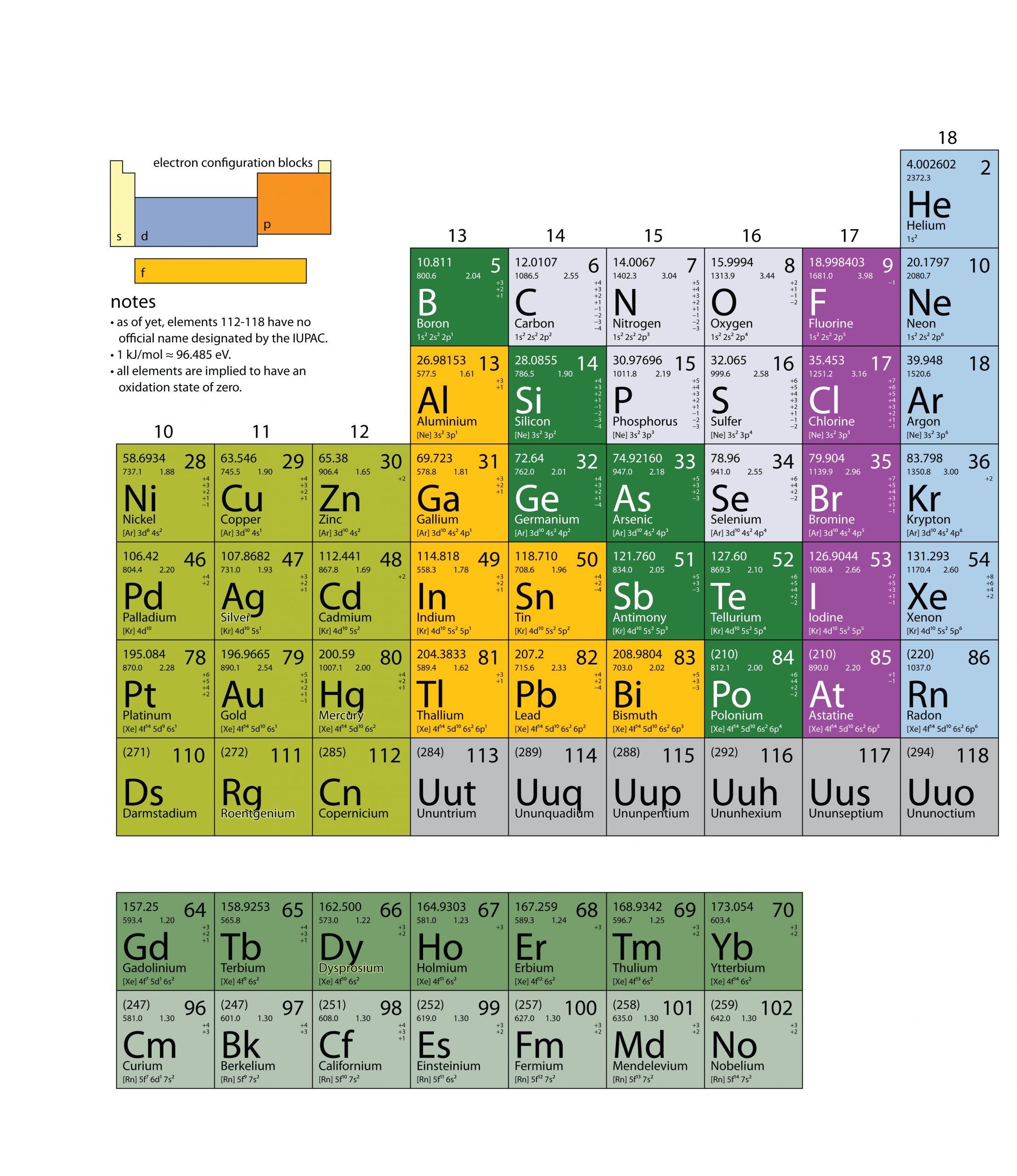| Periodic Table of the Elements – STEM for Educators | 您所在的位置:网站首页 › stem book › Periodic Table of the Elements – STEM for Educators |
Periodic Table of the Elements – STEM for Educators
|
Periodic Table of the Elements
David W. Ball Periodic Table of the Elements In this chapter, we present some data on the chemical elements. The periodic table lists all the known chemical elements, arranged by atomic number (that is, the number of protons in the nucleus). The periodic table is arguably the best tool in all of science; no other branch of science can summarize its fundamental constituents in such a concise and useful way. Many of the physical and chemical properties of the elements are either known or understood based on their positions on the periodic table. Periodic tables are available with a variety of chemical and physical properties listed in each element’s box. What follows here is a more complex version of the periodic table than what was presented other places in the book. The Internet is a great place to find periodic tables that contain additional information. One item on most periodic tables is the atomic mass of each element. For many applications, only one or two decimal places are necessary for the atomic mass. However, some applications require more decimal places. The atomic masses of some elements are known very precisely, to a large number of decimal places. The atomic masses of other elements, especially radioactive elements, are not known as precisely. Some elements, such as lithium, can have varying atomic masses depending on how their isotopes are isolated. The web offers many interactive periodic table resources. For example, see http://www.ptable.com.
Table 17.1 The Basics of the Elements of the Periodic Table Name Atomic Symbol Atomic Number Atomic Mass Footnotes actinium* Ac 89 aluminum Al 13 26.9815386(8) americium* Am 95 antimony Sb 51 121.760(1) g argon Ar 18 39.948(1) g, r arsenic As 33 74.92160(2) astatine* At 85 barium Ba 56 137.327(7) berkelium* Bk 97 beryllium Be 4 9.012182(3) bismuth Bi 83 208.98040(1) bohrium* Bh 107 boron B 5 10.811(7) g, m, r bromine Br 35 79.904(1) cadmium Cd 48 112.411(8) g caesium (cesium) Cs 55 132.9054519(2) calcium Ca 20 40.078(4) g californium* Cf 98 carbon C 6 12.0107(8) g, r cerium Ce 58 140.116(1) g chlorine Cl 17 35.453(2) g, m, r chromium Cr 24 51.9961(6) cobalt Co 27 58.933195(5) copernicium* Cn 112 copper Cu 29 63.546(3) r curium* Cm 96 darmstadtium* Ds 110 dubnium* Db 105 dysprosium Dy 66 162.500(1) g einsteinium* Es 99 erbium Er 68 167.259(3) g europium Eu 63 151.964(1) g fermium* Fm 100 fluorine F 9 18.9984032(5) francium* Fr 87 gadolinium Gd 64 157.25(3) g gallium Ga 31 69.723(1) germanium Ge 32 72.64(1) gold Au 79 196.966569(4) hafnium Hf 72 178.49(2) hassium* Hs 108 helium He 2 4.002602(2) g, r holmium Ho 67 164.93032(2) hydrogen H 1 1.00794(7) g, m, r indium In 49 114.818(3) iodine I 53 126.90447(3) iridium Ir 77 192.217(3) iron Fe 26 55.845(2) krypton Kr 36 83.798(2) g, m lanthanum La 57 138.90547(7) g lawrencium* Lr 103 lead Pb 82 207.2(1) g, r lithium Li 3 [6.941(2)]† g, m, r lutetium Lu 71 174.967(1) g magnesium Mg 12 24.3050(6) manganese Mn 25 54.938045(5) meitnerium* Mt 109 mendelevium* Md 101 mercury Hg 80 200.59(2) molybdenum Mo 42 95.94(2) g neodymium Nd 60 144.242(3) g neon Ne 10 20.1797(6) g, m neptunium* Np 93 nickel Ni 28 58.6934(2) niobium Nb 41 92.90638(2) nitrogen N 7 14.0067(2) g, r nobelium* No 102 osmium Os 76 190.23(3) g oxygen O 8 15.9994(3) g, r palladium Pd 46 106.42(1) g phosphorus P 15 30.973762(2) platinum Pt 78 195.084(9) plutonium* Pu 94 polonium* Po 84 potassium K 19 39.0983(1) praseodymium Pr 59 140.90765(2) promethium* Pm 61 protactinium* Pa 91 231.03588(2) radium* Ra 88 radon* Rn 86 roentgenium* Rg 111 rhenium Re 75 186.207(1) rhodium Rh 45 102.90550(2) rubidium Rb 37 85.4678(3) g ruthenium Ru 44 101.07(2) g rutherfordium* Rf 104 samarium Sm 62 150.36(2) g scandium Sc 21 44.955912(6) seaborgium* Sg 106 selenium Se 34 78.96(3) r silicon Si 14 28.0855(3) r silver Ag 47 107.8682(2) g sodium Na 11 22.98976928(2) strontium Sr 38 87.62(1) g, r sulfur S 16 32.065(5) g, r tantalum Ta 73 180.94788(2) technetium* Tc 43 tellurium Te 52 127.60(3) g terbium Tb 65 158.92535(2) thallium Tl 81 204.3833(2) thorium* Th 90 232.03806(2) g thulium Tm 69 168.93421(2) tin Sn 50 118.710(7) g titanium Ti 22 47.867(1) tungsten W 74 183.84(1) ununhexium* Uuh 116 ununoctium* Uuo 118 ununpentium* Uup 115 ununquadium* Uuq 114 ununtrium* Uut 113 uranium* U 92 238.02891(3) g, m vanadium V 23 50.9415(1) xenon Xe 54 131.293(6) g, m ytterbium Yb 70 173.04(3) g yttrium Y 39 88.90585(2) zinc Zn 30 65.409(4) zirconium Zr 40 91.224(2) g *Element has no stable nuclides. However, three such elements (Th, Pa, and U) have a characteristic terrestrial isotopic composition, and for these an atomic mass is tabulated. †Commercially available Li materials have atomic weights that range between 6.939 and 6.996; if a more accurate value is required, it must be determined for the specific material. g Geological specimens are known in which the element has an isotopic composition outside the limits for normal material. The difference between the atomic mass of the element in such specimens and that given in the table may exceed the stated uncertainty. m Modified isotopic compositions may be found in commercially available material because it has been subjected to an undisclosed or inadvertent isotopic fractionation. Substantial deviations in the atomic mass of the element from that given in the table can occur. r Range in isotopic composition of normal terrestrial material prevents a more precise Ar(E) being given; the tabulated Ar(E) value and uncertainty should be applicable to normal material.Source: Adapted from Pure and Applied Chemistry 78, no. 11 (2005): 2051–66. © IUPAC (International Union of Pure and Applied Chemistry). |
【本文地址】

